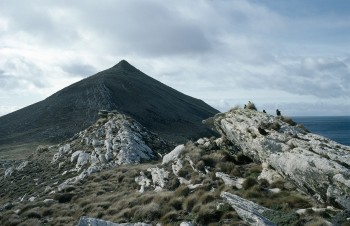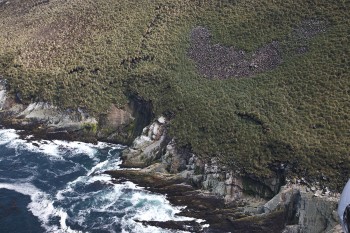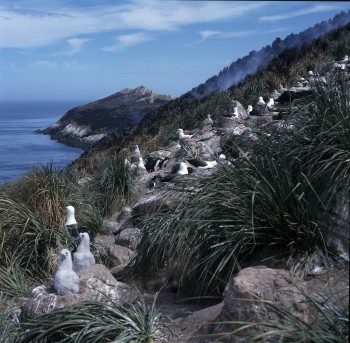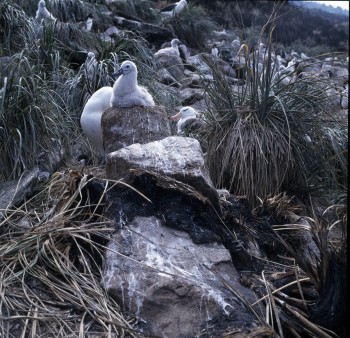South Jason falls within Jason Island Group, part of the Falkland Islands (Islas Malvinas)*, lying north-west of West Falkland. South Jason is a long (7 km) narrow island with a central spine that rises to 288 m and has an area of 375 ha.
The island is government-owned and is a National Nature Reserve designated in 1973. It forms part of the Jason Islands Group Important Bird Area. There is currently no management plan for the island. Only one ACAP-listed species breeds (in two colonies) on South Jason: the Black-browed Albatross Thalassarche melanophris.

South Jason Island from the southern point looking north to the main part of the island and its central ridge. The east side of the ridge (right in photo) is largely covered in Tussac (Tussock) Grass Poa flabellata, the west side (left in photo) is composed mainly of short heath-type vegetation
The island gained media attention in January 2001 when a fire accidentally swept through the east side of the island following the disposal of munitions from a Skyhawk aircraft, which had crashed into the west side of the island. Three independent surveys were made at different times to assess the damage caused by the fire. It is speculated that the fire destroyed a colony of Black-browed Albatrosses. A fire that previously burnt the island in January 1960 lasted four to five months. The island was probably burnt in 1949 as well. Because of the fire risk permits to visit the island come with a warning.

A 2010 aerial view of the larger Black-browed Albatross colony situated on the island’s east side showing recovery of the Tussac Grass
The main South Jason albatross colony is one of the fastest growing albatross colonies in the region. In the 2005 survey a total of 1550 breeding pairs was recorded. In the 2010 survey 2189 pairs were counted, reflecting the increase that has been observed elsewhere in the Falkland Islands (Islas Malvinas)*. A few (c. 35 pairs) albatrosses breed in a separate colony on the island.

A Black-browed Albatross colony with young birds five days after the fire with smouldering Tussac Grass stools in the background

Part of the Black-browed Albatross colony five days after the fire with burnt Tussac Grass leaf litter and stools showing how the fire had encroached to the edge of the colony
Two dead albatross chicks were observed, but no proof that the fire had been responsible for their death. No evidence of dead Southern Rockhopper Penguins Eudyptes chrysocome or their chicks was found, although a small number of Magellanic Penguins Spheniscus magellanicus which breed in burrows beneath the Tussac Grass stools died as a result of the fire.

Aerial view of the east side of the island sometime after the fire
Photographs by Ian Strange
See ACAP Breeding Sites accounts for two other islands in the group: Steeple Jason and Elephant Jason.
Selected References:
Catry, P., Forcada, J. & Almeida, A. 2011. Demographic parameters of Black-browed Albatrosses Thalassarche melanophris from the Falkland Islands. Polar Biology 34: 1221-1229.
[Falklands Conservation] 2006. Important Bird Areas of the Falkland Islands. London: Falklands Conservation. 160 pp.
Strange, I.J. 2001. Ground Survey of South Jason Island following Fire. Unpublished Report. 19 pp.
Strange, I.J. 2008. Aerial Surveys of Black-browed Albatross Thalassarche melanophris: the Methodology Employed and Comparisons with Surveys Carried out in 1986-2005-2006 and 2007. New Island: Design in Nature & Falkland Islands Wildlife. 59 pp.
Strange, I.J. & Strange, G. 2011. Black-browed Albatross Thalassarche melanophris. Aerial Photographic Survey Methodology: Advantages over Ground Surveying in the Falkland Islands. Results and Comparisons with Surveys in 2005 and 2010. Stanley: Design in Nature. 30 pp.
Wheeler, T. 2004. The Falklands & South Georgia Island. Footscray: Lonely Planet Publications. 200 pp.
Wolfaardt, A.[C.] 2012. An Assessment of the Population Trends and Conservation Status of Black-browed Albatrosses in the Falkland Islands. 23 pp.
Wolfaardt, A.C., Rendell, N. & Brickle, P. 2010. Falkland Islands Implementation Plan for the Agreement on the Conservation of Albatrosses and Petrels (ACAP): Review of Current Work and a Prioritised Work Programme for the Future. Stanley: Falkland Islands Government. 57 pp.
Ian Strange, New Island Conservation Trust, New Island, Falkland Islands (Islas Malvinas)* & John Cooper, ACAP Information Officer, 30 August 2013
*A dispute exists between the Governments of Argentina and the United Kingdom of Great Britain and Northern Ireland concerning sovereignty over the Falkland Islands (Islas Malvinas), South Georgia and the South Sandwich Islands (Islas Georgias del Sur y Islas Sandwich del Sur) and the surrounding maritime areas.

 English
English  Français
Français  Español
Español